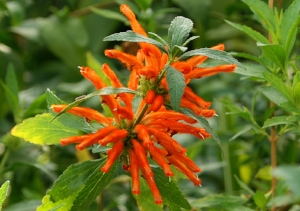Leonotis leonurus (The Lion’s ear)
Common English name: Lion’s ear, Lion’s tail.
Common Arabic name: Dhayl al-nimr (ذيل النمر) .
Botanical name: Leonotis leonurus.
Origin: Native to South Africa.
Group: Deciduous shrub.
Size: Grows to a height of 0.7m, with a spread of 0.7m.
Flowering season: May to October. Flowers bloom in late spring to autumn.
Growth: Fast growing. Takes six months to one year to reach its mature size.
Requirements: Should be planted in an open, sunny position, as it will not flower in the shade. It prefers a dry soil and is drought-resistant. Suits well-drained, mulched ground. It also is frost tender.
Water usage: Requires little watering (once a week).
Appearance: A handsome, decorative, sparingly branched, erect shrub. Has tall stems with lance-shaped leaves and whorls of tubular, bright orange flowers. Leaves are 5 –12cm long, and are hairy-toothed. The tubular flowers, which are 5cm long, come in bright orange, yellow, or orange-yellow, arranged in successive whorls up the stem. The orange whorls stand above the foliage for months.
Notes on use: Ideal for the back of borders, or as a focal point planted in large containers on the patio. May be treated as a hardy perennial. Effective as a solitary plant or in groups. Combines well in borders as a colorful accent with subtropical succulents such as Agave, Dracena, and Aloe species. May also be used for color contrast in borders with shrubby perennials such as Salvia officinalis and Rosmarinus officinalis.
Propagation: Propagation is by seed or cuttings taken in spring. Cuttings root easily at any time of the year. For good-sized plants cuttings should be taken in early spring. Striking cuttings in cactus mix after removing most of their leaves (to reduce transpiration) is the most satisfactory method.
Sowing instructions: Sow from mid February to March on the surface of a good seed compost just covering the seed with a thin layer of compost. Germination takes 14 – 21 days at 18 – 20 degrees centigrade. Sealing in a polythene bag after sowing is helpful. Lower the temperature after germination. The seedlings are naturally tall and resemble nettle seedlings at first.
Growing instructions: When large enough to handle, transplant the seedlings to boxes or 7.5 cm pots. When well grown, gradually acclimatize to outdoor conditions and plant out in late spring at distances of 1 – 1.25 m apart, and in full sun and well-drained soil.
Maintenance: Cut back to within 15cm of the ground in late February. Cut back spent flowers.
Notes: This plant is attractive to bees, butterflies and/or birds.
Traditional uses: Lion’s tail, also known as Wild Dagga, is smoked or made into a medicinal tea by some South African tribes. It also is used in eastern medicine as a euphoriant, purgative, and vermifuge (a medication capable of causing the evacuation of parasitic intestinal worms).
Image source:http://www.plantmaster.com
Image source: Image source: http://plantinfo.co.za
This article is part of a series of articles prepared by the Center for the Study of the Built Environment (CSBE) on water conserving landscapes.
For additional information on water conserving gardens, visit the CSBE web site at www.csbe.org
Support for the CSBE project on water conserving landscapes is provided by WEPIA (Water Efficiency and Public Information for Action), a program being implemented in collaboration with the Ministry of Water and Irrigation and funded by the United States Agency for International Development (USAID).


